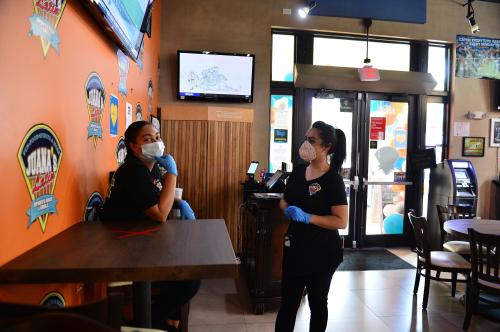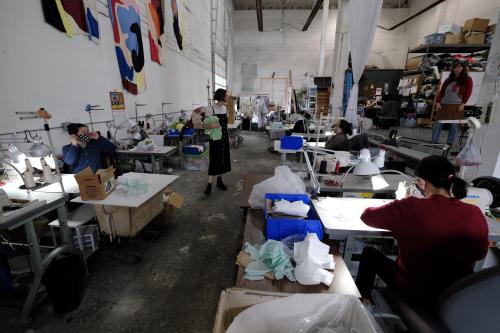On May 28, the U.S. House of Representatives passed the Paycheck Protection Program Flexibility Act, which aims to modify the $660 billion Paycheck Protection Program (PPP) to make loans more accessible and flexible for the nation’s struggling small business sector. After a surge in demand for PPP loans in the program’s first several weeks, both the number and volume of loans has flatlined since May 8, with over 40% of the program’s second funding tranche still available.
The PPP Flexibility Act would extend the loan forgiveness period from eight weeks to 24 weeks, extend the June 30 hiring deadline to receive forgiveness, and allow for greater flexibility to include nonpayroll expenses in forgiveness. These reforms reflect how many small businesses are not applying due to lack of guidance or concerns that they will not be able to get their loan forgiven. Even for those who did apply, many are still waiting.
Using data from the U.S. Census Bureau’s Small Business Pulse Survey, this post examines trends across the nation’s 50 largest metropolitan areas on two of the key dimensions for making the PPP successful for any local community: (1) maximizing applications through effective outreach and guidance, and (2) delivering the relief to businesses as fast as possible.
Business closure rates and PPP application rates vary across major metro areas
The intensity of the small business crisis differs across geography due to the varying severity of the pandemic, levels of lockdown orders, and industry exposure. To get a sense of the regional demand for small business liquidity relief, we use the share of surveyed small businesses that reported revenue loss from COVID-19. Nationwide, 66% of surveyed small businesses experienced a revenue loss from April 26 to May 23, but that varied among the 50 largest metro areas—from 74% of small businesses in Buffalo, N.Y. to 58% of small businesses in Jacksonville, Fla. and Salt Lake City (Chart 1).

In general, a metro area with more revenue loss will have a higher PPP application rate—but there are some notable exceptions. Fewer than 70% of small businesses in New Orleans, Miami, and Providence, R.I. have applied for PPP assistance, even though small businesses there experienced above-average revenue loss.
In the upper left portion of Chart 1, Midwestern and Southern metro areas had below-average revenue loss but some of the nation’s highest shares of PPP applications, led by Memphis, Tenn., Columbus, Ohio, Austin, Texas, and Virginia Beach, Va.
The race to deliver liquidity relief
If applying to the PPP is the first step in stabilizing the sector, processing loans to local small businesses is the second. In general, PPP processing rates in most large metro areas had stabilized at around 90% by May 23 (Chart 2), meaning that for every 10 businesses that said they applied to the program, around nine had received their loan. As these rates approach 100%, it underscores the importance of increasing accessibility to broaden the base of applying businesses now that application backlogs are cleared.
But the uneven progress in earlier weeks is still concerning. By May 2, one month after the PPP’s launch, only 50% of small businesses that applied had received their loan. Again, this varied by metro area: In Minneapolis, Oklahoma City, Okla., Kansas City, Mo., and Birmingham, Ala., about 70% of small businesses that applied had received PPP loans. At the same time, small businesses in the bottom five metro areas—all located in California—only saw 30% of their PPP applications processed by May 2.

This lag matters because it may indicate where small businesses have already gone under. By early May, small businesses had been forced to withstand about six weeks of stay-at-home orders, which means that the PPP processing rate in early May is critical because that was the point when many small businesses were about to run out of cash.
Nationwide, 54% of small businesses indicated that they had less than four weeks of cash flow on hand in early May, ranging from 68% in Buffalo to 38% in Columbus (Chart 3). Small businesses in New York, Riverside, Calif., and Hartford, Conn. were particularly short on cash, and the low PPP processing rates in those metro areas in early May mean those small businesses might not have received the essential assistance in time.

Three actions to support local small business stabilization efforts
These findings underscore that the small business crisis is widespread but locally differentiated in its severity and response, and point to three main takeaways for policymakers.
First, banks, credit unions, community development financial institutions (CDFIs), economic development groups, local government leaders, and small business owners understand how the nation’s relief strategy is playing out on the ground, and can be a powerful and practical advocate for needed changes. While the PPP is far from perfect, modifying it to be more accessible and flexible is likely the most politically palatable near-term solution. The Paycheck Protection Program Flexibility Act was approved by a vote of 417-1, a rare show of bipartisan support that was likely bolstered by a push from a wide set of constituencies. Institutions that are closest to the problem should maintain this local-federal feedback loop.
Second, there is still a need for continued outreach and guidance to small businesses that would benefit from the PPP but have not yet received their loan or even applied. The program’s recent plateau is not a sign that the job is done, as conversations with local leaders indicate that many small businesses (such as microbusinesses with fewer than 10 employees and businesses in communities of color) are still not being served by the PPP. Bolstering CDFI capacity is a universal recommendation we have heard over the last several weeks to help increase accessibility to federal relief.
Third, there needs to be additional support from the federal government for local outreach and technical assistance related to loan forgiveness. According to a recent survey conducted by National Federation of Independent Business, 75% of surveyed small business owners find the terms and conditions of the PPP loan difficult to understand. Indeed, the process for loan forgiveness is likely to be more complicated than the process for loan applications, which means that there needs to be a commensurate investment in local capacity to help small business owners with technical assistance.
This analysis has shown that, after wide local variation in PPP applications and receipts, lenders across the nation’s 50 largest metro areas have been able to process most of the loans in their backlogs. But there are still small businesses—particularly those that had been underbanked or unbanked—that likely could benefit from access to the PPP, but require additional outreach and guidance through community-based business networks supported by federal legislation. Supporting these local technical assistance networks will also be critical in helping more vulnerable small businesses obtain loan forgiveness. Without it, the paperwork burden and somewhat confusing rules and regulations could leave small businesses with debts that they cannot sustain.








Commentary
Small businesses have received uneven relief from COVID-19 federal aid
May 29, 2020